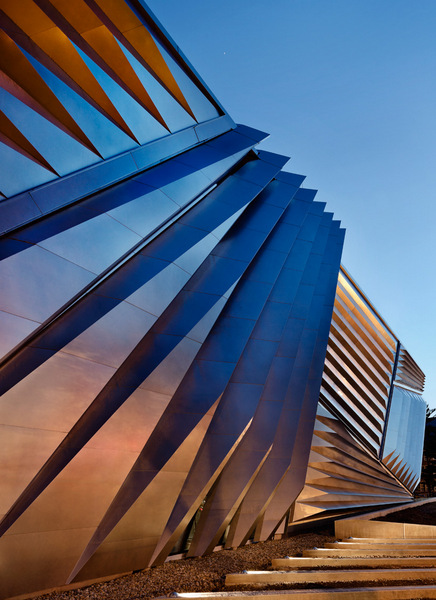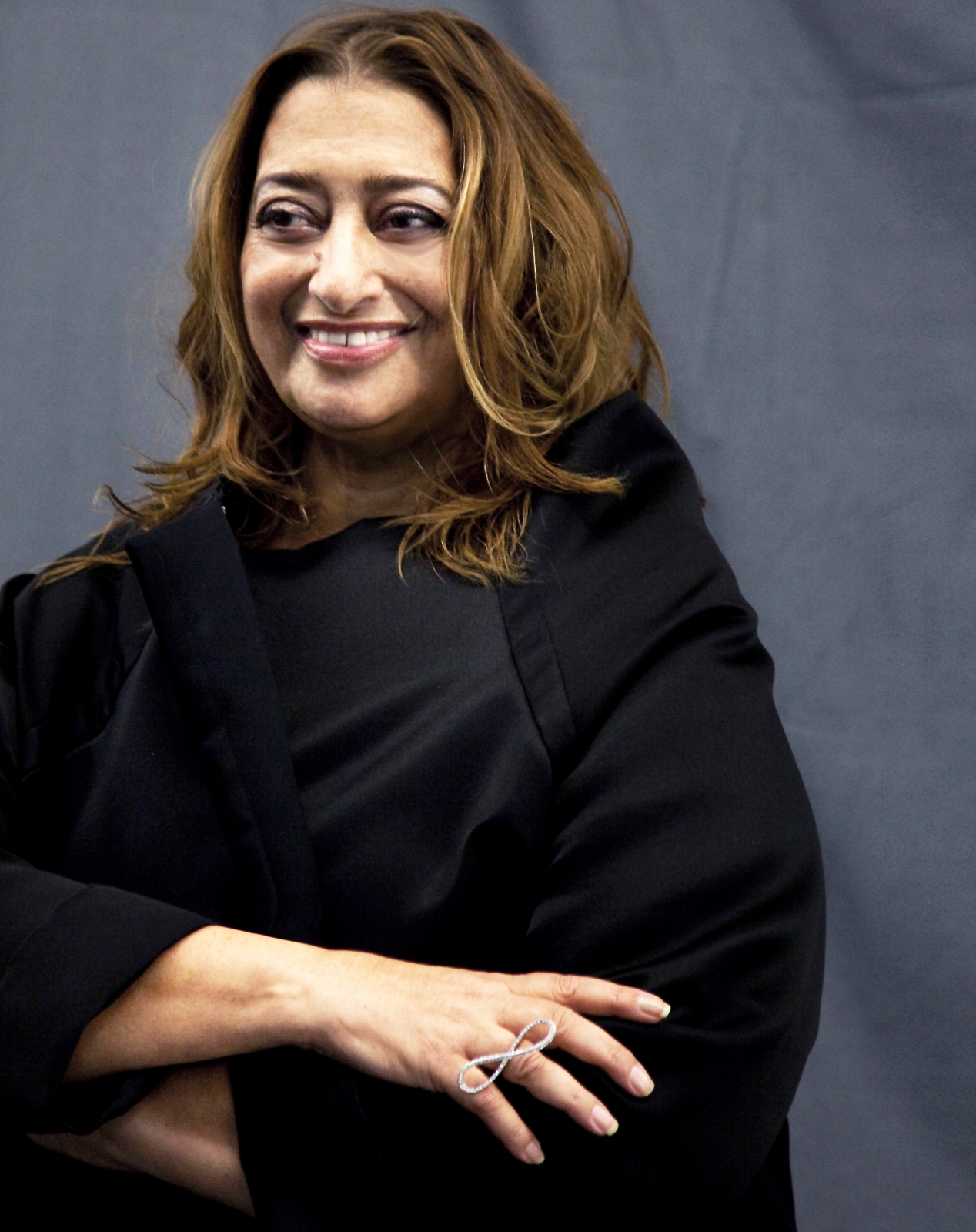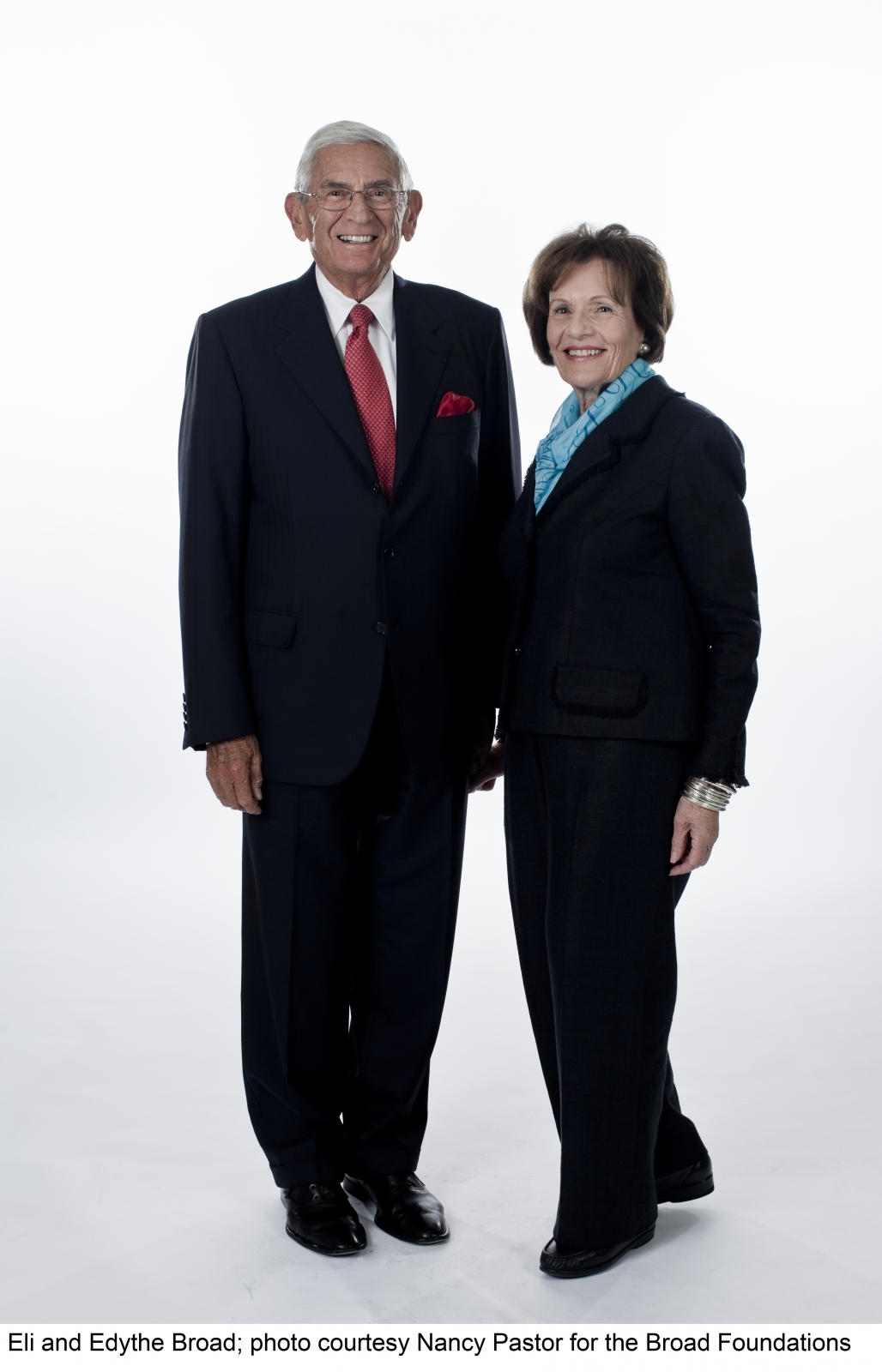
Broad Ambitions in the Heartland: Zaha Hadid Designs Broad Art Museum at MSU
Ninety minutes from Detroit, the home of the hard-core MC5, heavy metal has risen its graceful stubborn head. The Eli and Edythe Broad Art Museum, designed by Zaha Hadid, is a sleek formation of pleated stainless steel that unites an ensemble of trapezoidal spaces. If it isn’t an homage to the industrial past of the heartland, it’s a challenge to anything in the man-made environment nearby.

The Eli and Edythe Broad Art Museum – The Only Trapezoid for Miles
If challenge weren’t the right word, the university would not have sited the museum on the road at the edge of its vast campus. This way, the public can’t miss it. Universities that depend on good relations with state legislators tend to avoid giving too much attention to contemporary art, fearful of the Mapplethorpe effect. Not here, in a museum named for donors Eli and Edythe Broad, whose (clothed) portraits by Mapplethorpe are featured in the “Regarding Warhol” exhibition at the Metropolitan Museum of Art.

Zaha Hadid Puts a “Dialogue of Geometries” Into Steel and Concrete
The Broad Museum’s shape is the product of “a dialogue of different geometries,” Hadid said. “The formal composition of the Broad is derived from the landscape around it. Its stainless steel cladding appears to change constantly with different light and viewing perspectives – the directional pleats echoing the unique topography and circulation routes of the campus,” she observed. “Michigan’s long tradition of innovation and skilled manufacturing has enabled us to deliver a building of the highest material and finish quality.”
To call the new building a patterned slab gets it right. In the midst of rectilinear brick campus buildings of different generations that serve a population of more than 40,000, the Broad Museum, with its ship-hull pleats, finds a beachhead for contemporary art in the domain of football and agriculture. Hadid designed it to look more like an extrusion from the earth than a gift dropped from the skies.
Yet the museum is largely the gift of Eli Broad, who graduated from Michigan State with a degree in accounting and decamped to make a fortune in California, building affordable houses for veterans and other buyers of low income. Broad is now one of the country’s leading cultural benefactors – a mark of his own longstanding generosity and of the inertia of many others. His name is on the business school and on the school of management at MSU. Now it is on a museum devoted mostly to contemporary art, for which he provided some $28 million of the almost $50 million required to build and open it. The building expresses nothing if not its own durability, accepting the ambition of bringing Koons to the cornfields. Broad is a Koons collector and Koons himself was on hand for the opening.

Broad hopes that Hadid’s angular design – an anomaly in these parts — will also bring tourists. “It will have a mini-Bilbao effect,” he said, defying the reputation of Michigan as the deindustrialized home of Michael Moore and Jack Kevorkian that is losing population.
“The building clearly announces the university’s desire to be firmly planted in this new century, and in the next century,” said Michael Rush, the Broad Museum’s new director.
Most recently, Rush was director of the Rose Museum at Brandeis University, where trustees tried to sell off the art and close the museum after its endowment shrank in the 2008 banking crisis.
“This is a place that couldn’t be more different,” he said of his new institution.
The Broad, Rush noted “has a very futuristic patina to it. The word that I keep using about it is its dynamism, — this building is almost literally launching toward the future.”
“Most museums – the Metropolitan, the Louvre – any of our great museums. When you go into them, you feel a certain reverence, you feel a silence, you feel a magnificence,” he said.
“That is not the feeling with this building,” Rush stressed. “When you come into this building you feel off kilter – the windows lean toward the East or the West. The galleries are not white boxes. Once you’re caught off guard like that, it heightens your perception, your attention, and your sensitivities. This is very congruent with what artists have been doing, at least since the 1960’s, trying to redirect our perceptions.”
In the galleries, videos in “Global Groove 1973/2012” ranged from Nam June Paik to The Propeller Group’s tour through street graffiti in Ho Chi Minh City to Bashar Alhroub’s view of a wire security cage above an Arab market. The observation by Basir Mahmood of Pakistan of his father trying to thread a needle could be a metaphor for the skeptical view of the task of building an audience for this kind of art in East Lansing.
Paper mache bodies by the Chinese-born artist Chen Qiulin are frozen in somersaults (suspended by wire) in a gallery nearby.
Below grade, in a gallery space arranged with chairs in auditorium style is the inaugural crowd-pleaser, Evolution (Megaplex) by Marco Brambilla, a 3D video of dozens of scenes from cinema history arranged in dense overlay in what looks like a revolving globe. The vignettes, projected in forward and reverse movement, have a three-dimensional presence that feels sculptural. Visitors of all ages will be absorbed by it.
The soft-spoken Rush was formerly a Jesuit priest. He is also trained as a psychologist, and practiced at Bellevue Hospital in Manhattan, among other places, a background that I suggested might help with trustees.
“I hope,” he laughed.
